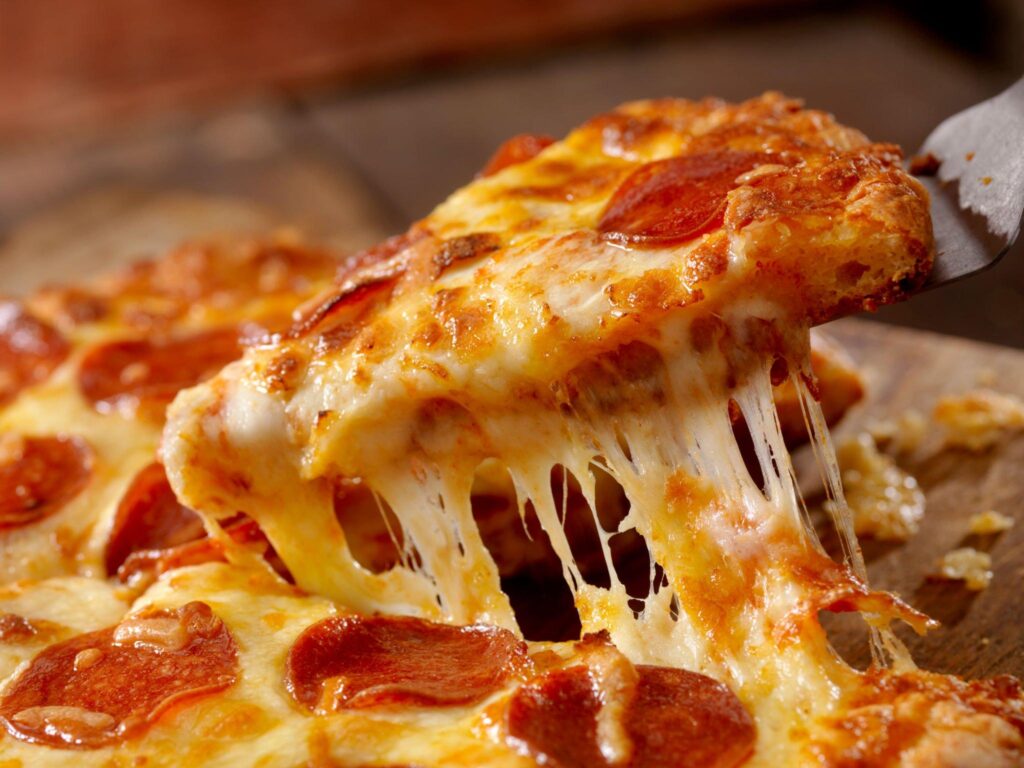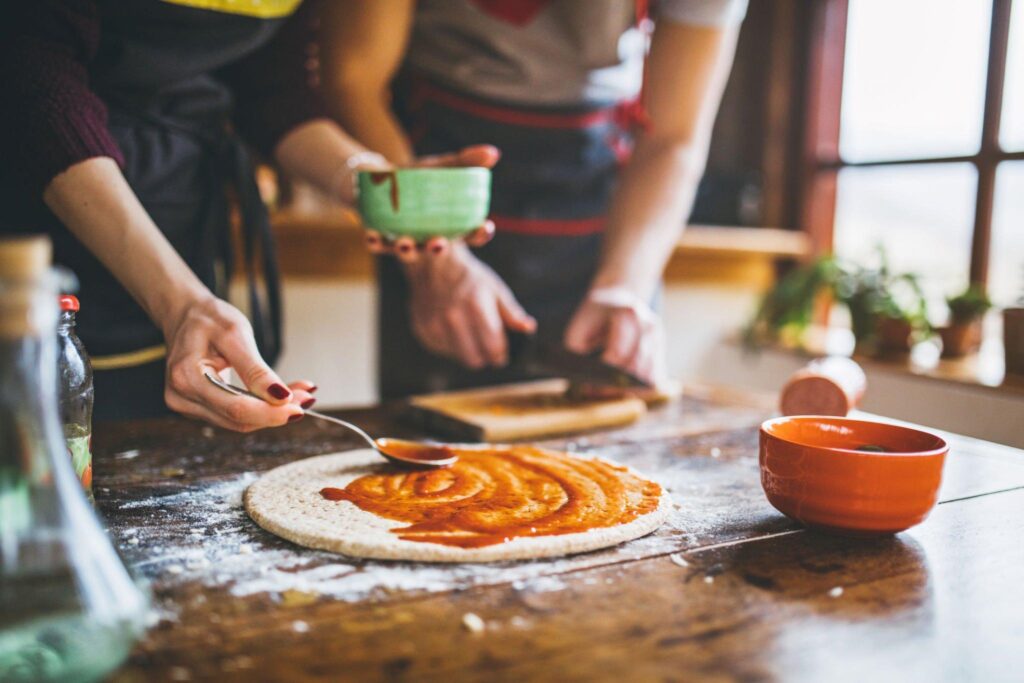Introduction
Pizza, the ultimate guilty pleasure for many people, is a beloved dish that has captured the hearts and taste buds of millions around the world. Whether you indulge in a classic Margherita or go all out with a loaded meat lover’s pizza, there’s no denying the allure of this cheesy, saucy creation. But have you ever wondered how many calories in pizza?
The Popularity Of Pizza As A Guilty Pleasure
There’s something about pizza that makes it irresistible. Its versatility, convenience, and deliciousness make it a top choice for quick meals, social gatherings, and late-night cravings. Pizza is timeless and enjoyed by people of all ages and cultures. From traditional pizzerias to gourmet pizzerias, there’s a pizza for everyone’s taste preferences.
Understanding The Importance Of Counting Calories
While indulging in pizza can be a delightful experience, it’s essential to be mindful of its impact on your health and well-being. Counting calories is a helpful tool to manage your weight, make informed food choices, and maintain a balanced diet. By understanding the calorie content of your favorite pizza slices, you can make adjustments to your overall calorie intake and make healthier choices without sacrificing taste and enjoyment.
When it comes to counting calories in pizza, the numbers can vary greatly depending on the type of crust, toppings, and portion size. A thin-crust cheese pizza typically contains around 200-300 calories per slice, while a meat lover’s deep-dish pizza can have 400-600 calories per slice. It’s essential to be aware of these numbers and consider them in the context of your overall dietary needs and goals.
Remember, enjoying pizza in moderation and practicing mindful eating habits can allow you to savor the guilty pleasure without compromising your health.
Pizza Calories 101
We all love indulging in a delicious slice of pizza, but have you ever wondered how many calories are hiding in that guilty pleasure? Let’s take a closer look at the basic components of a pizza and how different toppings and crust choices can affect its calorie count.
The Basic Components Of A Pizza And Their Calorie Content
A typical pizza consists of three main components: the crust, sauce, and cheese. The calorie content of each component can vary depending on the size and thickness of the slice.
- Crust: The crust is made of dough, which is typically high in carbohydrates. A thin-crust pizza can range from 150-200 calories per slice, while a thicker crust can contain around 250-300 calories per slice.
- Sauce: Tomato sauce is commonly used as the base for pizzas and is relatively low in calories. A regular-sized slice of pizza with tomato sauce contains approximately 30-50 calories.
- Cheese: Cheese is a significant contributor to the calorie count of a pizza. A slice of pizza with mozzarella cheese can have around 100-150 calories, depending on the amount of cheese used.
How Different Toppings And Crust Choices Affect Calorie Count?
The calorie content of a pizza can increase significantly based on the toppings and crust choices. Here are a few examples:
- Meat toppings: Adding pepperoni, sausage, or bacon can add an extra 50-100 calories per slice.
- Vegetable toppings: Vegetables like mushrooms, onions, and peppers are lower in calories compared to meat toppings, contributing around 5-20 calories per slice.
- Crust choices: Opting for a whole wheat or thin crust can reduce the calorie count while choosing a stuffed crust or deep-dish crust can add extra calories.
It’s important to note that these calorie estimates are approximate and can vary depending on the size and specific ingredients used in each pizza. Being mindful of your portion sizes and choosing healthier toppings like vegetables can help you enjoy your favorite pizza guilt-free.
In conclusion, while pizza can be a delicious indulgence, being aware of its calorie content can help you make more informed choices and enjoy your slices in moderation.
Write only 277 words in an article about How Many Calories In Pizza? – Pizza’s Guilty Pleasure: Counting Calories in Your Favorite Slices. in Third Person POV and Friendly tone covering these key points:
Traditional Pizza Vs. Specialty Pizza
Exploring The Calorie Differences Between Traditional And Specialty Pizzas
When it comes to pizza, everyone has their guilty pleasure. But have you ever wondered how many calories are hiding in your favorite slices? Whether you’re a fan of traditional pizzas or prefer more unique specialty options, it’s important to be aware of the calorie differences.
Traditional pizzas typically include classic toppings like cheese, tomato sauce, and pepperoni. These ingredients are relatively moderate in calories, with a medium-sized slice of cheese pizza clocking in at around 200-300 calories. However, if you add extra cheese, meat, or other high-calorie toppings, the calorie count can increase significantly.
On the other hand, specialty pizzas offer a wide variety of unique flavors and toppings. While these pizzas can be incredibly delicious, they tend to be higher in calories due to the addition of ingredients like bacon, sausage, or creamy sauces. A medium-sized slice of a specialty pizza can range anywhere from 300-500 calories, depending on the toppings.
Analyzing Popular Choices Like Margherita, Pepperoni, And BBQ Chicken Pizzas
Let’s take a closer look at some popular pizza choices and their approximate calorie counts.
- Margherita Pizza: This classic Italian favorite typically features fresh mozzarella cheese, tomato sauce, and basil. A medium-sized slice of Margherita pizza contains around 250-300 calories.
- Pepperoni Pizza: A beloved choice among pizza lovers, a medium-sized slice of pepperoni pizza can have anywhere from 300-350 calories. The richness of the pepperoni adds to the overall calorie count.
- BBQ Chicken Pizza: This flavorful specialty pizza combines barbeque sauce, grilled chicken, onions, and cheese. A medium-sized slice of BBQ chicken pizza usually ranges from 350-400 calories.
Remember, these calorie counts are approximate and may vary depending on the size and specific ingredients used by different pizza establishments. If you’re watching your calorie intake, it’s a good idea to enjoy pizza in moderation and be mindful of portion sizes.
Healthier Pizza Options
Exploring Healthier Alternatives To Traditional Pizza
Craving a slice of pizza but worried about the calorie count? Don’t fret! There are healthier options available that can satisfy your pizza cravings without derailing your diet.
Overview Of Cauliflower Crust, Whole Wheat Crust, And Gluten-free Crust Options
- Cauliflower crust: Made from cauliflower, this crust is a great low-carb alternative. It’s not only lower in calories but also gluten-free. Cauliflower crusts can be found in stores or made at home using cauliflower rice, cheese, and egg as the main ingredients.
- Whole wheat crust: Opting for a whole wheat crust adds essential fiber and nutrients to your pizza. Whole wheat is less processed and retains more nutritional value compared to refined white flour. Look for whole wheat crust options at your local pizzeria, or make your own using whole wheat flour.
- Gluten-free crust: For those with gluten intolerance or sensitivity, gluten-free crusts are a perfect choice. These crusts are typically made from alternative flours like rice flour, almond flour, or a blend of various gluten-free flours. Many pizza places now offer gluten-free options on their menu.
When it comes to topping choices, opt for lean proteins like grilled chicken or turkey instead of high-fat meats. Load up on veggies like spinach, bell peppers, and mushrooms, which provide essential vitamins and minerals. Be mindful of cheese and choose lower-fat options or use less cheese altogether.
Remember, moderation is key. While these healthier options can be a part of a balanced diet, it’s still important to be mindful of portion sizes and overall calorie intake. So go ahead and enjoy a guilt-free slice of pizza!
Calorie Counting Tips For Pizza Lovers
Pizza is undoubtedly a guilty pleasure for many people, but that doesn’t mean you can’t enjoy it while also being mindful of your calorie intake. With the right strategies, you can still savor your favorite slices without going overboard on the calories.
Practical Strategies For Reducing Calorie Intake When Indulging In Pizza
When it comes to enjoying pizza without feeling guilty about the calorie content, here are some practical tips you can follow:
- Choose Thin Crust: Opting for a thin-crust pizza instead of a thick crust can significantly reduce your calorie intake. Thin crusts generally contain fewer carbohydrates and calories, making them a lighter choice.
- Load Up on Veggies: Enhance the nutritional value of your pizza by adding plenty of vegetables as toppings. Vegetables not only provide essential vitamins and minerals but also add volume to your pizza, allowing you to feel satisfied with fewer slices.
- Control Portion Sizes: One of the most effective ways to watch your calorie intake is to control portion sizes. Instead of devouring the entire pizza, try having a smaller slice or sharing it with someone else.
Portion Control, Mindful Eating, And Topping Choices
Being mindful of your eating habits and making smart choices can make a significant difference when it comes to calorie consumption:
- Mindful Eating: Slow down and savor each bite of your pizza. Eating mindfully helps you appreciate the flavors and textures, making you more conscious of how much you are eating.
- Choose Lighter Toppings: Opt for lean protein toppings like grilled chicken or shrimp, and go easy on high-fat toppings like extra cheese or pepperoni. These choices can help reduce the calorie content of your pizza.
- Consider Alternative Crusts: Nowadays, there are many options for alternative crusts, such as cauliflower crust or whole wheat crust. These can be a healthier choice compared to traditional white flour crusts.
By implementing these strategies, you can still enjoy your favorite pizza while keeping your calorie intake in check. Remember, moderation is key, and making conscious choices can help you find a balance between indulgence and a healthy lifestyle.
Hidden Calories: The Extras On Pizza
Addressing The Additional Calorie Sources Like Cheese, Sauce, And Oil
We all love a good slice of pizza, but have you ever wondered how many calories are hiding in your favorite pies? While the number varies depending on the size, toppings, and crust, it’s essential to be aware of the additional calorie sources that can sneak into your pizza.
Cheese: Cheese is a significant calorie contributor, especially if you pile it on. One ounce of cheese adds around 100-120 calories to your pizza. Opting for a lighter cheese or reducing the amount can help curb calorie intake.
Sauce: Tomato sauce is generally low in calories, but some pizza places use heavy sauces or add sugar, which increases the calorie count. Ask for light sauce or opt for alternative sauces like pesto or olive oil to save on calories.
Oil: Many pizzas come brushed with oil or have oil drizzled on top. While it adds flavor, it also adds calories. Consider asking for no extra oil or blotting it with a napkin before eating.
Strategies For Reducing Hidden Calories Without Compromising Taste
- Choose a thin crust: Thin crust pizzas generally have fewer calories compared to deep-dish or thick crust options.
- Load up on veggies: Adding a variety of vegetables as toppings not only enhances the flavor but also increases the nutritional value without piling on too many calories.
- Go for lean protein: Opt for lean protein options like grilled chicken or shrimp instead of high-calorie meats like sausage or pepperoni.
- Watch portion sizes: Be mindful of how many slices you’re consuming. Limiting yourself to 1-2 slices and enjoying a side salad can help control calorie intake.
It’s important to remember that indulging in pizza occasionally is perfectly fine. Moderation and making conscious choices can help you enjoy your favorite slices without guilt.
Pizza Chains And Calorie Awareness
A Closer Look At Calorie Transparency In Popular Pizza Chains
When it comes to our favorite guilty pleasure, pizza, it’s important to be aware of the number of calories we are consuming. Many popular pizza chains have recognized the need for calorie transparency and have started providing this information to their customers.
For example, Pizza Hut now offers a “nutrition calculator” on their website, allowing customers to see the calorie content of each menu item. Domino’s pizza has also followed suit, providing an online calorie tracker that enables customers to make informed choices about their pizza selections.
These efforts to increase calorie awareness are not limited to national chains. Local and regional pizza establishments are also stepping up and providing nutritional information to their customers. This transparency allows individuals to make choices that align with their dietary needs and goals.
The Impact Of Menu Labeling On Consumer Choices
Research has shown that menu labeling, which includes displaying calorie information, can have a significant impact on consumer behavior. When customers are aware of the calories in their food, they are more likely to choose lower-calorie options.
One study conducted by researchers at Stanford University found that when calorie counts were displayed next to menu items, consumers ordered meals with an average of 100 fewer calories. This shows the importance of calorie awareness in promoting healthier choices.
Overall, calorie transparency in pizza chains plays a vital role in helping consumers make informed decisions about their meals. By providing this information, pizza chains are empowering individuals to be more conscious of their calorie intake and make choices that can contribute to a healthier lifestyle.
So, next time you indulge in a slice of pizza, take a moment to check the calories and opt for a lighter option if you’re watching your intake.
Balancing Pizza With A Healthy Lifestyle
For many people, pizza is an all-time favorite guilty pleasure. The combination of melted cheese, savory sauce, and toppings on a crispy crust is undeniably delicious. However, with concerns about calories and nutrition, you may be wondering if you can still enjoy pizza while maintaining a healthy lifestyle.
Incorporating Pizza Into A Balanced Diet And Active Lifestyle
- Portion control: One of the keys to enjoying pizza guilt-free is practicing portion control. Instead of devouring an entire pizza by yourself, please share it with friends or family. Pair it with a side salad or a plate of vegetables to increase the nutritional value of your meal.
- Opt for healthier options: Look for pizzerias that offer whole wheat or thin crust options. These alternatives are generally lower in calories and provide more fiber. Additionally, choose leaner protein toppings like grilled chicken or shrimp instead of fatty meats like pepperoni or sausage.
- Load up on vegetables: Add a variety of vegetables as toppings to increase the nutritional value of your pizza. Broccoli, spinach, bell peppers, and mushrooms are not only delicious but also packed with vitamins and minerals.
Tips For Enjoying Pizza In Moderation Without Guilt
- Choose quality over quantity: Instead of ordering a large pizza, opt for a smaller size or a personal pizza. This way, you can satisfy your cravings without overindulging.
- Balance it out: If you’re going to enjoy a slice of pizza, make sure to balance it out with healthier choices throughout the day. Incorporate plenty of fruits, vegetables, lean proteins, and whole grains into your other meals and snacks.
- Savor each bite: Instead of mindlessly eating, take the time to savor each bite of your pizza. Enjoy the flavors, textures, and aromas. Eating slowly can help you feel more satisfied with fewer slices.
Remember, enjoying pizza in moderation can still be part of a healthy lifestyle. By practicing portion control, choosing healthier options, and balancing your meals, you can satisfy your pizza cravings without feeling guilty. So go ahead and indulge in a slice or two while maintaining a balanced diet and active lifestyle.
FAQ: How Many Calories are in Pizza? – Pizza’s Guilty Pleasure: Counting Calories in Your Favorite Slices
Q: Why do people count calories in pizza?
A: Counting calories in pizza is a common practice for those who are conscious of their calorie intake and trying to maintain a healthy diet. Pizza can be high in calories, especially when loaded with toppings and cheese. By counting calories, individuals can better understand portion sizes and make informed choices about their food consumption.
Q: How many calories are in an average slice of Westside Pizza?
A: An average slice of Westside Pizza contains approximately 240 calories. However, it’s important to note that the calorie content may vary depending on the type and size of the slice, as well as the toppings and crust used.
Q: Is calorie counting the only way to control weight?
A: No, calorie counting is just one method of weight management. While it can be effective for some people, it’s not the only way to control weight. Other factors like portion control, balanced nutrition, and physical activity also play important roles in maintaining a healthy weight.
Q: Can exercise compensate for excess calories consumed?
A: Exercising can help burn calories, but it may not always compensate for the excess calories consumed through food. It’s essential to find a balance between calorie intake and physical activity to achieve weight management goals effectively.
Q: How can I enjoy social events without feeling guilty about the excess calories?
A: It’s important to find a balance between enjoying social events and maintaining a healthy lifestyle. Instead of solely focusing on calorie counting, try incorporating mindful eating habits and portion control. Allow yourself to indulge occasionally without guilt while also making healthy choices in between.
Q: Can calorie counting become unhealthy for mental health?
A: Yes, calorie counting can become unhealthy for mental health if it triggers anxiety, obsessive thoughts, or feelings of guilt surrounding food. Suppose calorie counting starts to affect your mental well-being. In that case, it may be helpful to seek advice from a healthcare professional or registered dietitian to develop a more balanced approach to eating.
Q: How can I judge accurately what hunger is and when to listen to the body’s cravings?
A: Judging hunger accurately and listening to the body’s cravings can be challenging. A good starting point is to pay attention to physical hunger cues, such as stomach grumbling or feeling lightheaded. It’s also important to distinguish between true hunger and emotional or stress-related cravings. Learning to trust your body’s signals and eating mindfully can help with understanding hunger and responding appropriately.
Q: How can I enjoy occasional indulgences without sabotaging my calorie goals?
A: Balancing occasional indulgences while maintaining calorie goals is possible. If you know that you will be consuming extra calories on certain days, try adjusting your eating patterns before or after the event. Consider making healthier choices during other meals or increasing physical activity to compensate for the excess calories. Remember, moderation is key, and a well-rounded, sustainable approach to eating is more important than restricting yourself excessively.
Q: Is it necessary to count calories to have a fit body and enjoy life?
A: No, it’s not necessary to count calories to have a fit body and enjoy life. While calorie awareness can be helpful for some, it’s just one approach to managing weight and overall health. Building a balanced and sustainable lifestyle that includes regular physical activity, nutritious food choices, and mindful eating habits can be more effective in achieving long-term health goals.
Conclusion
Pizza is undoubtedly a beloved guilty pleasure for many, but understanding its calorie content doesn’t mean sacrificing enjoyment. By making informed choices and being mindful of portion sizes, you can still enjoy pizza while fitting it into a healthy eating plan.
Understanding The Calorie Content Of Pizza Without Sacrificing Enjoyment
Pizza can vary significantly in terms of calorie content depending on the size, toppings, and crust type. It’s important to be aware of these factors to make informed choices. Opting for thinner crusts, like thin crust or cauliflower crust, can help reduce calorie intake. Additionally, choosing vegetables and lean protein as toppings can help keep the calorie count lower.
Being mindful of portion sizes is also key. It’s easy to indulge in multiple slices, but this can quickly add up the calories. One approach is to pair a smaller pizza portion with a side salad or other healthy accompaniments to create a more balanced meal.
Making Informed Choices To Fit Pizza Into A Healthy Eating Plan
If you’re looking to fit pizza into a healthy eating plan, there are a few strategies to consider. Moderation is key – enjoying pizza occasionally rather than as a regular staple can help keep calorie intake in check. You can also opt for homemade pizza, where you have control over the ingredients and portion sizes.
Another tip is to balance your pizza meal with healthier choices throughout the day. For example, if you’re planning to have pizza for dinner, make sure to include plenty of fruits, vegetables, and lean protein in your earlier meals.
Remember, counting calories doesn’t mean depriving yourself of the things you enjoy. With mindful choices and moderation, you can still savor your favorite pizza slices while maintaining a balanced and healthy lifestyle.

Looking for delicious pizza and authentic Italian cuisine? Look no further than Claudia R. Diaz at Joe’s NY Pizza in Tonawanda! Our menu features a wide variety of classic dishes and innovative creations, all made with the freshest ingredients and prepared with the utmost care. Whether you’re in the mood for a traditional Margherita pizza or something a little more adventurous, like our Buffalo chicken pizza or shrimp scampi pasta, Claudia R. Diaz has something to satisfy every craving. So why wait? Visit us today and experience the best Italian food in Tonawanda! #ClaudiaRDiaz #JoesNYPizzaTonawanda #ItalianFood #PizzaLovers #FoodiesUnite



